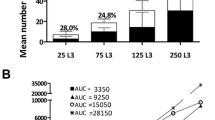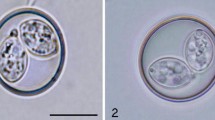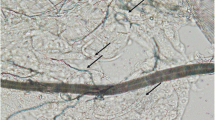Summary
Experiments were carried out with a strain ofEimeria falciformis on more than 3,000 mice to clarify the infectious behaviour.
The course of development takes place mainly in the caecum and in the upper half of the colon. In the jejunum single schizonts can be found and in the ileum several are found more or less regularly, but gametocytes can be demonstrated very seldom in the small intestine. The greater the inoculum, the larger is the part of the intestine that becomes infected. Stadia of the first schizogony generation are often found in the epithelial cells of the villi and the later stadia of development above all in the crypts. A schizogony generation is completed in 1.5 to 2 days, the gametocytes need 2 days to mature. Gametocytes can already develop from the merozoites of the 1st generation. Normally however, they develop out of the 2nd or 3rd and rarely from the 4th schizogony generation.
The duration of the oocyst production depends on the number of inoculated oocysts. It lasts, at a maximum, from the 4th to 16th day. After reinfection, the excretion of oocysts begins anew. A full immunity is reached only after the 4th inoculation. The sporulation of oocysts requires 36 hrs to 5 days at 22° C. The oocysts that are excreted during the first days take longer to sporulate than those found in the feces from the 8th day on. The material for infection does not loose its infectivity for 3–4 months when potassium bichromate is added and then kept at +6° C. After 16 months storage at least 10% of the oocysts are still infective. Sporulated oocysts generally survive deep-freeze conservation at −79° C only 11 days. Single specimen however could be kept considerably longer.
Oral, subcutaneous, intramuscular, intraveneous and intraperitoneal inoculation of oocysts cause identical infections.
The course of infection is neither influenced by splenectomy, nor by keeping the mice at a lower temperature (+15° C instead of 20–24° C) the dose of infection influences the clinical symptoms. The reproductive potential is inversely proportional to the number of inoculated oocysts.
The merozoites are, in regard to their further development to gametocytes or schizonts, not determined. The sexual determination must be phenotypical, since infections with only one merozoite also lead to a complete development ofE. falciformis.
Zusammenfassung
Die Entwicklung vonE. falciformis in der Maus wird beschrieben. Die Infektionsdosis beeinflußt direkt proportional die Schwere der klinischen Symptome, die Dauer der Oocystenausscheidung und die Ausdehnung der Infektion im Darm. Sie hat dagegen keinen Einfluß auf die Anzahl insgesamt ausgeschiedener Oocysten. Die Anzahl der Schizogoniezyklen ist nicht endogen festgelegt. Die Merozoiten sind hinsichtlich ihrer weiteren Entwicklung zu Schizonten oder Gamonten nicht determiniert, wie Übertragungsexperimente zeigten. Die Geschlechtsbestimmung der Merozoiten erfolgt phänotypisch. Auch intravenöse, intraperitoneale, intramuskuläre und subkutane Inokulation von Oocysten führt bei der Maus zu einem normalen Infektionsverlauf.
Similar content being viewed by others
Literatur
Becker, E. R.: Infection with a single coccidian oocyst and its significance. Amer. Naturalist68, 571–574 (1934).
Brackett, W., Bliznick, A.: The reproductive potential of five spezies of coccidia of the chicken as demonstrated by oocyst production. J. Parasit.38, 133–138 (1952).
Cerná, Z., Senaud, J.:Eimeria pragensis sp. n., a new coccidian parasite from the intestine of mice (Mus musculus). Fol. parasit. (Prag)16, 171–175 (1969).
Cordero del Campillo, M.: Estudios sobreEimeria falciformis (Emier, 1870) parasito del raton. An. Fac. Vet. Leon4, 55–73 (1959).
Davies, S. F. M., Joyner, L. P.: Infection of the fowl by the parenteral inoculation of Oocysts ofEimeria. Nature (Lond.)194, 996–997 (1963).
— Kendall, S. B.: Coccidiosis. Edinburgh and London: Oliver & Boyd 1963.
Doran, D. J., Vetterling, J. M.: Infectivity of two species of poultry coccidia after freezing and storage in liquid nitrogen vapour. Proc. helminth. Soc. Wash.36, 30–33 (1969).
Fish, F.: Quantitative and statistical analysis of infections withEimeria tenella in chicken. Amer. J. Hyg.14, 560 (1931).
Grell, K. G.: Entwicklung und Geschlechtsbestimmung vonEucoccidium dinophili. Arch. Protistenk.99, 156–186 (1953).
— Protozoologie. 2. Aufl. p. 174–175. Berlin-Heidelberg-New York: Springer 1968.
Hilbrich, P.: Krankheiten des Geflügels. 2. Aufl. S. 69 ff. Schwenningen/Neckar: H. Kuhn 1967.
Kendall, S. B.: Freeze preservation of strains ofEimeria. Vortrag auf III. Intern. Kongr. f. Protozoologie, Leningrad 2.–10. 7. 1969. s. Suppl. to the volume of Abstracts p. 16–17. Leningrad: Publishinghouse „Nauka“ 1969.
Kiedrowski, L.: Untersuchungen über die Einwirkungen verschiedener Mittel auf das Mäusekokzid. Inaug.-Diss. Berlin (1925).
Levine, N. D., Ivens, D.: The coccidian parasites (Protozoa, Sporozoa) of rodents, p. 131 ff. Urbana: The University of Illinois Press, 1965.
Nieschulz, O., Bos, A.: Über den Infektionsverlauf der Mäusekokzidiosis. Z. Infektionskrankheiten und Hyg. Haustiere39, 160–168 (1931).
Reich, F.: Das KaninchencoccidEimeria stiedae (Lindemann, 1865) nebsteinem Beitrag zur Kenntnis vonEimeria falciformis (Eimer, 1870). Arch. Protistenk.28, 1–42 (1913).
Reimer, O.: Zur Pathologie der Mäusekokzidiose. Diss. Tierärztl. Hochschule Berlin, (1923).
Rose, E.: The effect of splenectomy upon infection withEimeria tenella. Parasitology58, 481–487 (1968).
Ryley, J. F.: Chick embryo infections for the evaluation of anticoccidial drugs. Parasitology58, 215–220 (1968).
Schneider, A.: Note sur les rapports des psorospermies oviformes aux véritables Grégarines. Arch. Zool. exp. gén.4, 11–14 (1875).
Schuberg, A.: Die Coccidien aus dem Darme der Maus. Verh. naturhist.-med. Vereins Heidelberg5, 369–398 (1897).
Sharma, N. N.: Response of the fowl (Gallus domesticus) to parenteral administration of seven coccidial species. J. Parasit.50, 509–517 (1964).
Wagner, W. H., Foerster, O.: Die PAS-AO-Methode, eine Spezialfärbung für Coccidien im Gewebe. Z. Parasitenk.25, 28–48 (1964).
Wenyon, C. M.: Protozoology: A manual for medical men, veterinarians and zoologists. London: Bailliere, Tindall & Cox, 1926.
Author information
Authors and Affiliations
Rights and permissions
About this article
Cite this article
Haberkorn, A. Die Entwicklung vonEimeria falciformis (Eimer 1870) in der weißen Maus (Mus musculus). Z. F. Parasitenkunde 34, 49–67 (1970). https://doi.org/10.1007/BF00629179
Received:
Issue Date:
DOI: https://doi.org/10.1007/BF00629179




